ENTITRE
a tribute to physical matter in the digital age.
ENTITRE
Welcome to LWJ’s blog.
An editorial space illuminating the inspirations we draw from both East and West—spanning architecture, contemporary art, design and the intricate world of gemmology.
Fondazione Feltrinelli & Microsoft House
The Feltrinelli Fondation’s new building in the district of Porta Volta is a great example of how a positive social impact project can revitalise a neglected neighborhood and bring innovation through a combined architectural and urban solution.
Designed by architects Herzog & de Meuron, the modern glass building appears naked, like a skeleton where structure, space and façade coincide. The building’s minimalism brings to mind Milan’s medieval and gothic tradition, whereas the long stretched structure and repetitive window pattern echoes the region’s more rural Cascina architecture.
A third of the building is dedicated to the Giacommo Feltrinelli Fondation which combines the publishing group’s public bookshop and coffee shop, multipurpose hall for events and outstanding library compromised of more than 1.5 million archival items on historical, political, economic and social sciences matters. The Foundation is not only a place of study, research and conservation it prides itself in offering innovative educational and cultural activities such as exhibitions, conferences, plays, film screenings and concerts.
The rest of the building is occupied by Microsoft Italy and acts as their headquarters. Unlike most offices, three floors are open to the public: the ground floor, an open showroom showcasing Microsoft’s latest technologies, the first floor which houses the Microsoft Technology centre, an experiential centre for companies, startups and professionals to share ideas and discuss innovation and the Digital Classroom floor which provides a multimedia environment for students and teachers to learn about the latest education technologies. The rest of the building is allocated to Microsoft employees and combines open plan workstations with different areas designed for various workflows.
The ground on which the The Feltrinelli & Microsoft House is built used to be a wasteland and hadn’t been touched since the Second World War when Milan was severely bombed. Today the project is not only revitalizing the Porta Vera district, it is also honouring Milan’s past heritage, with the conservation of the former 16th century gate built during the Spanish occupation.
Read more about micro, soft Milano :
The Prada Foundation experience
Largo Isarco
It’s the middle of August 2020, the outside temperature is 38°C and the streets of Milan are mostly empty and quiet. Closed signs can be seen hanging from shop windows and tourists are scarce on account of the ongoing global COVID-19 pandemic.
But in Milan’s industrial Largo Isarco neighborhood ever since the arrival of the Fondation Prada in 2015, there’s trepidation in the air - real estate projects are soaring, showcasing the region’s current potential and attractivity.
The Prada Foundation
The Prada Fondation is the work of OMA, Rem Koolhaas’s international architecture practice along with its research branch AMO. The project consisted in converting an old distillery from 1910 which included the renovation of seven existing buildings and the construction of three news ones (Podium, Cinema and Torre) into a new arts centre over 19 000 square meters.
In comparison with other museums, the Prada Fondation’s specificity and originality lies in its capacity to offer an infinite number of spatial typologies available to present art.
The Torre is the complex’s final architectural element and most adaptable space. The 60m white rectangular tower allows for extensive freedom of display on every level, with a wide variety of ceiling heights from 2,7m to 8m and an infinity of modular configurations. The signature tower, also known for its trendy restaurant with an unprecedented view of Milan is the Prada Foundation’s latest building, it was inaugurated in 2018 and beautifully completes the art complex.
The Fondation’s Haunted House is another captivating space. Unlike the Torre, this space was not built from scratch but simply renovated and covered in gold-leaf. It creates an unbelievable impression on the imagination and superbly highlights the old distillery’s simple structure and design.
Facing the radiant Haunted House is the Fondation’s café Bar Luce, imagined by non other than filmmaker Wes Anderson. The café was inspired by Italian popular culture and aesthetics from the 1950s and 1960s and includes a range of colours and formica furniture echoing Anderson’s short film Castello Cavalcanti (2013).
Today, the Fondation Prada is one of the largest privately-funded contemporary art museum’s in Europe with approximately 13,000 square meters of exhibition space creating new opportunities for Milan’s industrial district where culture and production go hand in hand, bringing activity back to city centers.
Read more about micro, soft Milano :
Art, fashion and friars on the Piazza del Carmine
Situated on the Piazza del Carmine, just off the via Vetero in the historic district of Brera, the Church of Santa Maria del Carmine in Milan is well worth the visit.
The Church’s beautiful neo-gothic facade imagined and completed in 1880 by architect Carlo Maciachini (famous for his design of Milan’s Monumental Cemetery) is truly captivating. Its foundations date back to the late 13th century when the Carmelite Friars first settled in the region, but the current edification (besides the facade) was designed by friar and architect Bernardo da Venezia and in the late 14th century and took more than 50 years to build.
The Church of Santa Maria del Carmine was named after the religious Order of the Brothers of the Blessed Virgin Mary of Mount Carmel in Palestine. From time immemorial, this mountain has been considered the lush garden of Palestine and symbol of fertility and beauty. Indeed, "Karmel" means "garden" and it is deeply associated with the prophet Elijah who “defended the true faith in the God of Israel” and the Virgin Mary who lived “ in the footsteps of Jesus Christ”.
The Piazza del Carmine’s natural charm emanates not only from its history, but from the harmonious exchange that coexist between each architectural element that composes it from Igor Mitoraj’s land art marble sculpture to the recent opening on the Square of the Swedish nonconformist fashion brand Acne Studios. The shop’s grand arched glass windows and granite floors smoothly reciprocate the Church’s pointed arches and the Square’s cobbled pavement. On the other side of it, trendy Milanese can be seen conversing away underneath large white parasols at God Save the Food, a stylish eatery facing the fascinating facade of Santa Maria del Carmine.
Read more about micro, soft Milano
ruins and progress - MMXX pavilion by André Chami at Beirut Digital District
MMXX pavilion questions the relation between ruins and progress and the radiant squares of our civilisations
After having followed smartESA’s accelerator programme in Beirut to develop his activities between Europe and the Middle East, Versailles-based cultural entrepreneur and artist André Chami, alongside art consultant Christiane Ashkar, launched MMXX pavilion - a public art programme with a debut exhibition at the Beirut Digital District from the 20th -25th of September on technique and civilisation.
MMXX pavilion curator André Chami before a private visit of the show
MMXX pavilion is a public art initiative that offers unique out-of-museum exhibition formats where invited artists focus on integrating the context of a space within their work.
In conjunction with the 2019 Beirut Art Fair, André Chami curated MMXX pavilion at the Beirut Digital District on Damascus street, a zone that has been active since the beginning of mankind with guest artists Edgar Sarin and Sara Boy.
Edgar Sarin, represented by the Parisian gallery Michel Rein showcased new in-situ pieces produced on the BDD's rooftop following on from his work on technique. Singer-songwriter Sara Boy also made an appearance during the pavilion's opening, performing ambient storytellings.
French artist Edgar Sarin during his stay in Beirut
“vers l’exactitude du nuage” a new group of in-situ sculptures by French artist Edgar Sarin.
vers l'exactitude du nuage 3, Edgar Sarin
vers l'exactitude du nuage 2, Edgar Sarin
variation sur celui du cone de glace, Edgar Sarin 2019
About MMXX
MMXX pavilion questions a territory’s capacity to generate progress.
2020 was supposed to mark the first year of the Universal Exhibition in the Arab World, it has now been postponed to 2021 due to the Covid-19 pandemic.
By choosing to write 2020 in roman letters, MMXX pavilion questions the transition of innovation centres in the Latin and Arab world in their quest for progress.
From the port of Beirut up to Damascus street lies a zone that has been active since the beginning of mankind and that knows significant development projects such as the Beirut Digital District.
MMXX is a pavilion curated by André Chami that questions progress in different value systems through the lens of technique.
MMXX pavilion draws parallels between Versailles, the city of the Sun King and the Levant region.
Waiting on Jesus in Maghdouché
A few kilometers away from the city of Sidon in Southern Lebanon in the Christian village of Maghdouché lies the Melkite Shrine of Saydet El Mantara (Our Lady of Waiting), a Lebanese treasure and pilgrimage site still unbeknownst to many.
After many years of increased effort lead by the Bishop of Sidon Mgr. Elie Haddad along with a team of experts specialised in tracing the pedestrian routes followed by Jesus in South Lebanon, the site was recognized as an international Marian Shrine in 2016.
The sanctuary is located at the top of a hill, overlooking the coast and the city of Sidon. It consists of a tower crowned with the statue of the Virgin and Child, a cathedral, a cemetery and a sacred cave believed to be where the Virgin Mary rested and waited on Jesus when he preached in Sidon.
Some historians argue the worship of Mary by the Lebanese stems from their Pheonician ancestry and devotion to Astarthe as many places of worship dedicated to the goddess were later converted into Christian shrines and temples, including the Shrine of Saydet el Mantara.
The first Marian Shrine was built in 324 AD by the Emperor Constantine the Great at the request of his mother Saint Helena. The Shrine consisted of a tower, but unfortunately no traces are left as it was entirely destroyed in 550 AD after the earthquake. The Mantara grotto was then magically rediscovered centuries later in the 1720s by a shepherd when one of his sheep fell into a crevasse leading to the cave.
A Marian Shrine was then built in 1860 by the Melkite Church. A cemetery was also set up in its enclosure. The Mantara cave was later transformed into a church in the 1960s along with a 36-metre-high tower with a chapel at its base and a bronze statue of the Virgin Mary bearing Jesus Christ at its top.
DISCOVER OUR Miraculous Medals and X Shamballa bracelets inspired by the color of the Cathedral of Maghdouché.
Shrine Bright like Harissa
Known for their unshakable optimism, resourcefulness and resilience, the Lebanese have endured countless hardships over the past 50 years and the recent blast from Beirut’s port on August 4th 2020 is yet another blow to the cumulative challenges the country was already facing.
But in the thick of suffering and pain, hope and faith prevail.
For the multiconfessional state, unity and solace can be found in their shared devotion to the Virgin Mary. Adored and celebrated by Christians and Muslims alike, the Heavenly Mother provides a source of comfort, strength and harmony in times of trouble.
At the back of cars, niched upon building entrances, next to ATMS or elevated at the top of mountains, statues of Mary can be observed on every corner. Mentioned 72 times in the Bible, Lebanon is considered a Holy Land by Christians, the cities of Tyre and Sidon are often referenced in the Bible as places Jesus travelled to. According to Pope Jean Paul II during his visit to Beirut in 1997, “Lebanon is more than a nation, more than a country. It is a message”.
Of the country’s 3000 concentrated religious sites, the Marian Shrines of Harissa and Maghdouché, draw thousands of pilgrims every year. Known as Our Lady of Lebanon, the Shrine of Harissa belongs to the Maronite Patriarchate and is situated 550m above sea level in a small village half an hour from Beirut.
The Shrine is surrounded by 5 churches and is highlighted by a 15 ton bronze statue of the Immaculate Conception facing the sea with her arms stretched, embracing and protecting Beirut from harm. For many Lebanese, the very existence of Lebanon is linked to the Virgin Mary and the construction of Our Lady of Lebanon illustrates this belief as the Shrine was built in 1904, following the proclamation of the dogma of the Immaculate Conception in 1854 by the Pope Pie IX, when Lebanon was still under Ottoman domination.
Inside A.MUSE.UM, Nadim Karam’s creative studio
Known for his dreamlike sculptures and installations, Lebanese architect and artist Nadim Karam is full of surprises and the opening of A.MUSE.UM in 2018 was definitely one of them. Situated in the village of Daroun in the vicinity of the shrine of Our Lady of Lebanon, A.MUSE.UM is a unique private museum and studio space dedicated to art and creation.
A Wild Cat, one of Nadim Karam’s Urban Toy sculptures in downtown Beirut
Imagined like an inverted space, A.MUSE.UM is a dream for dreams. Built below the terraces of Karam’s childhood home, the space naturally espouses the surroundings and stands as the embodiment of the limitless possibilities of the creative mind. It is architecturally breathtaking and calls to mind the stark and spiritual buildings of Tadao Ando, whose classes Karam followed during his doctorate in architecture at the University of Tokyo in Japan in the 1980’s.
As we slowly make our way down the ramp into the heart of Karam’s creative bubble our senses are heightened by the smell of paint and the sight of unfinished canvases left to dry. On the wall a black and white painting catches our eye. It depicts a beautiful Ottoman style house with Karam’s signature child-like figures sitting and fishing on large steps of a leveled garden. A slender creature hovers over the joyful scene. The painting is a magical reiteration of Karam’s family home and studio space and its discovery further enhances our dreamlike visit allowing us to deeply connect with the artwork and experience an intimate and refreshing artistic occurence.
A.MUSE.UM was inaugurated in 2019 with the exhibition “Shorthand, Nadim Karam, Notes from the Archive” curated by Rachel Dedman in association with the Beirut Art Fair. Known for his public art sculptures the exhibition showcased hundreds of the Karam’s preliminary land art drawings, paintings and performance art videos from the past 40 years.
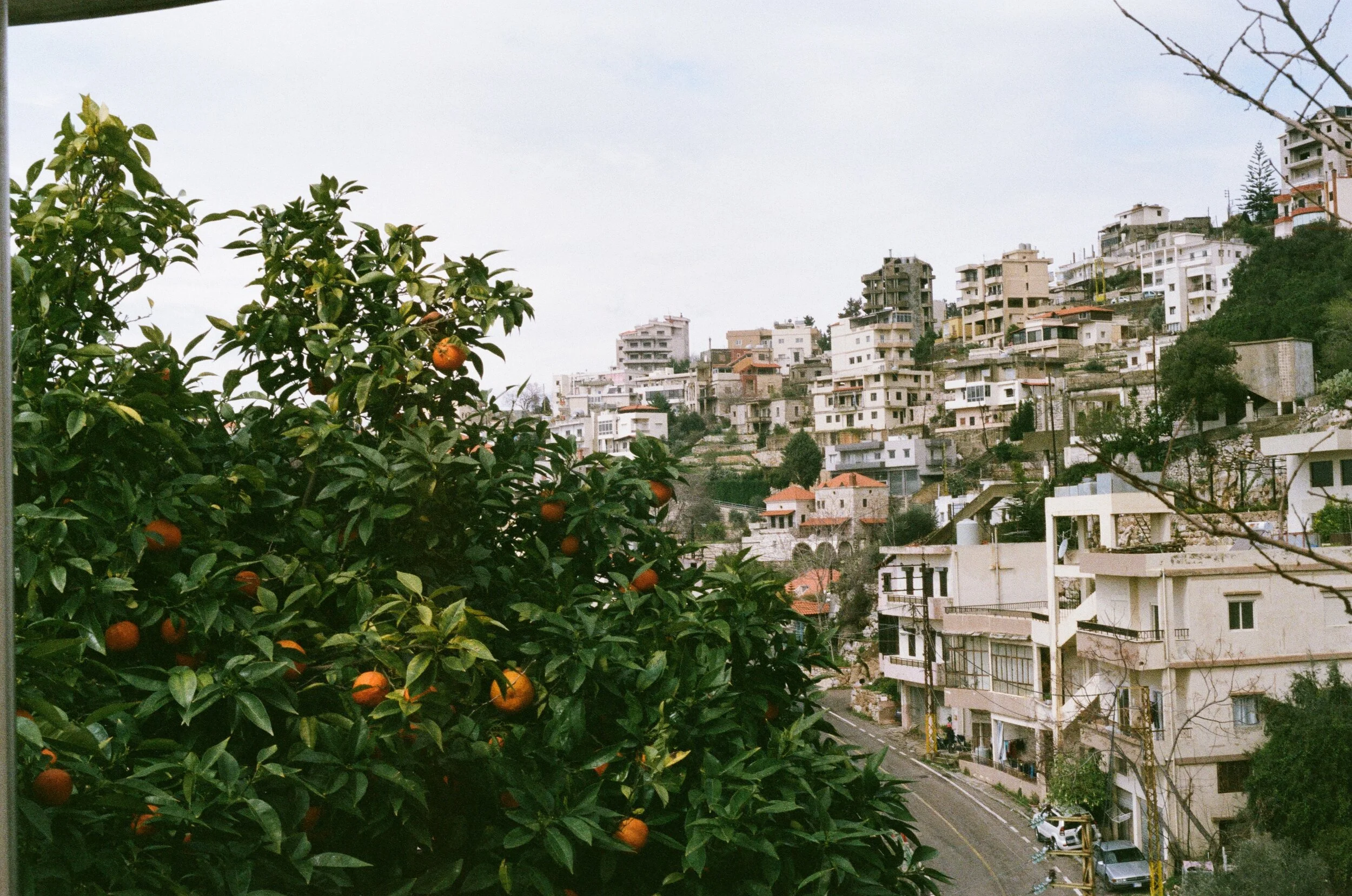
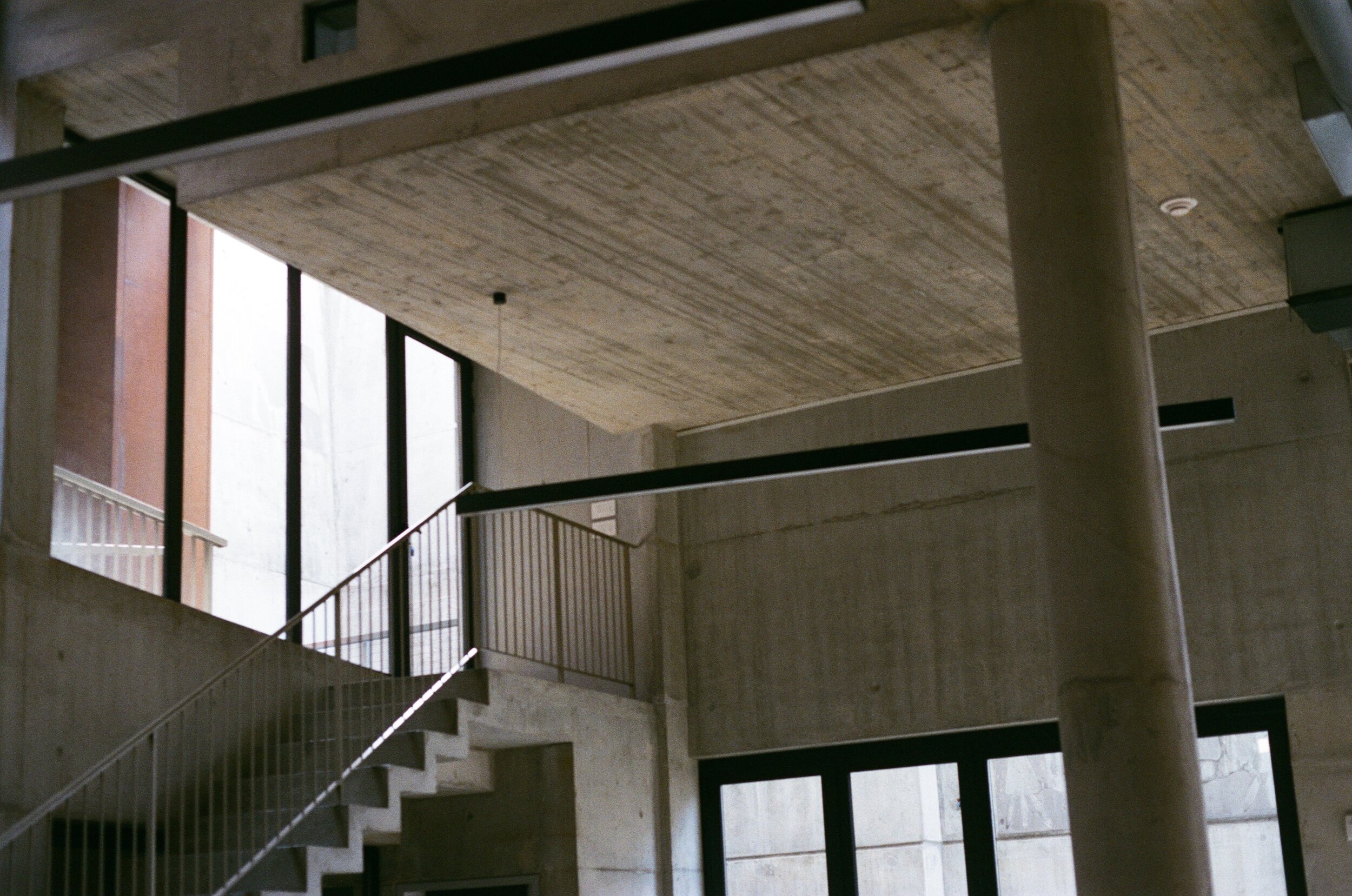
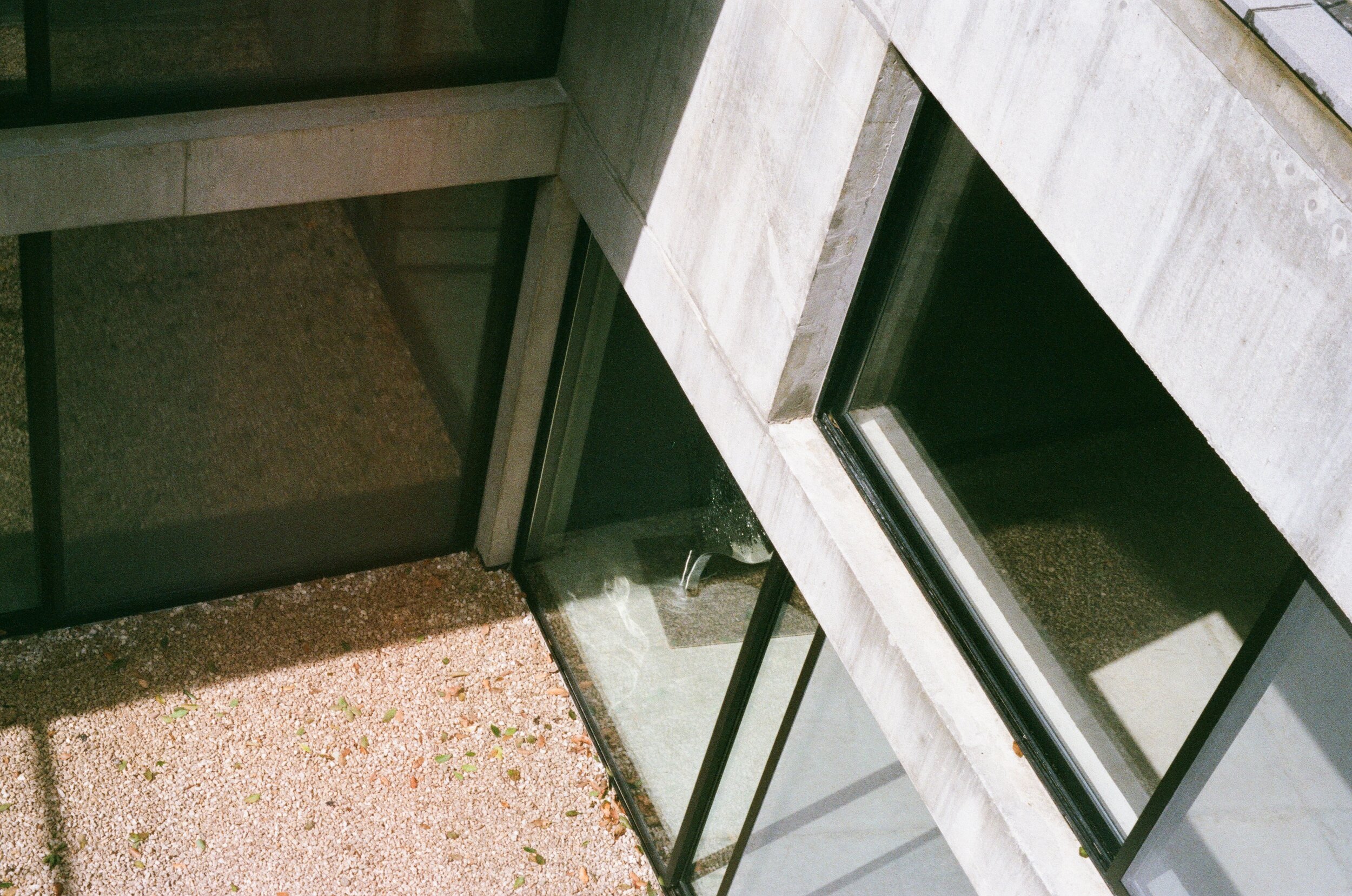
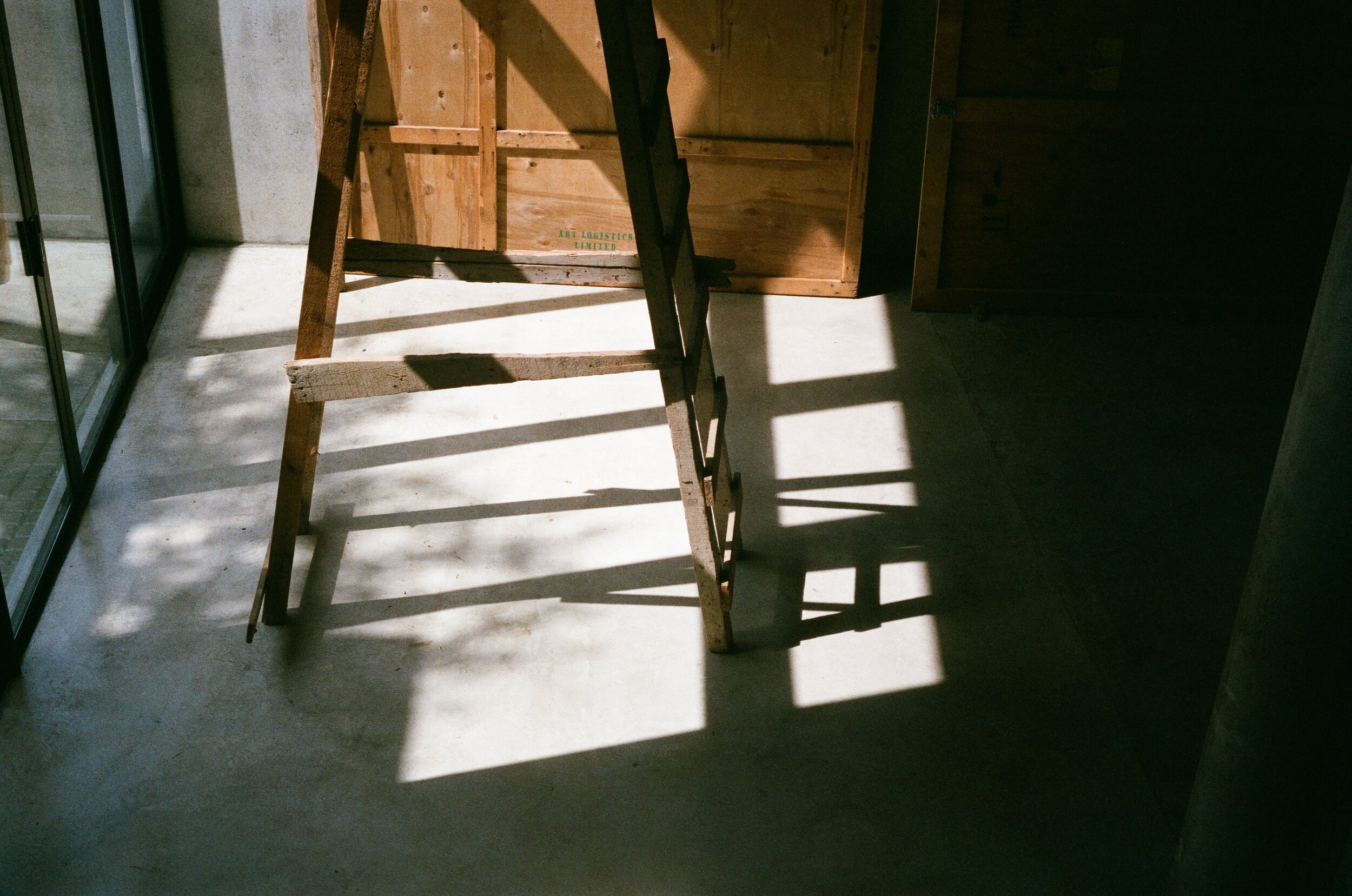
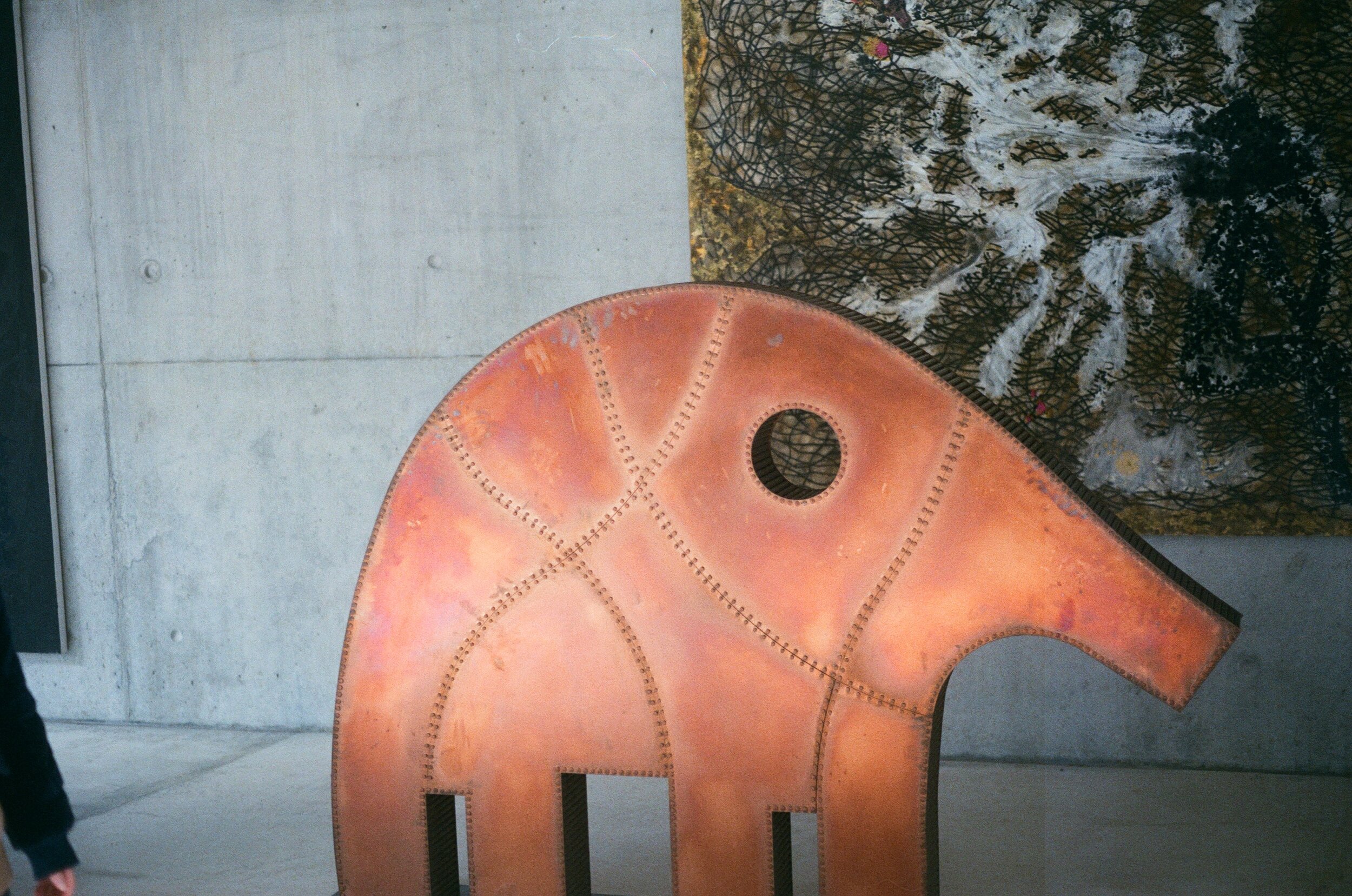
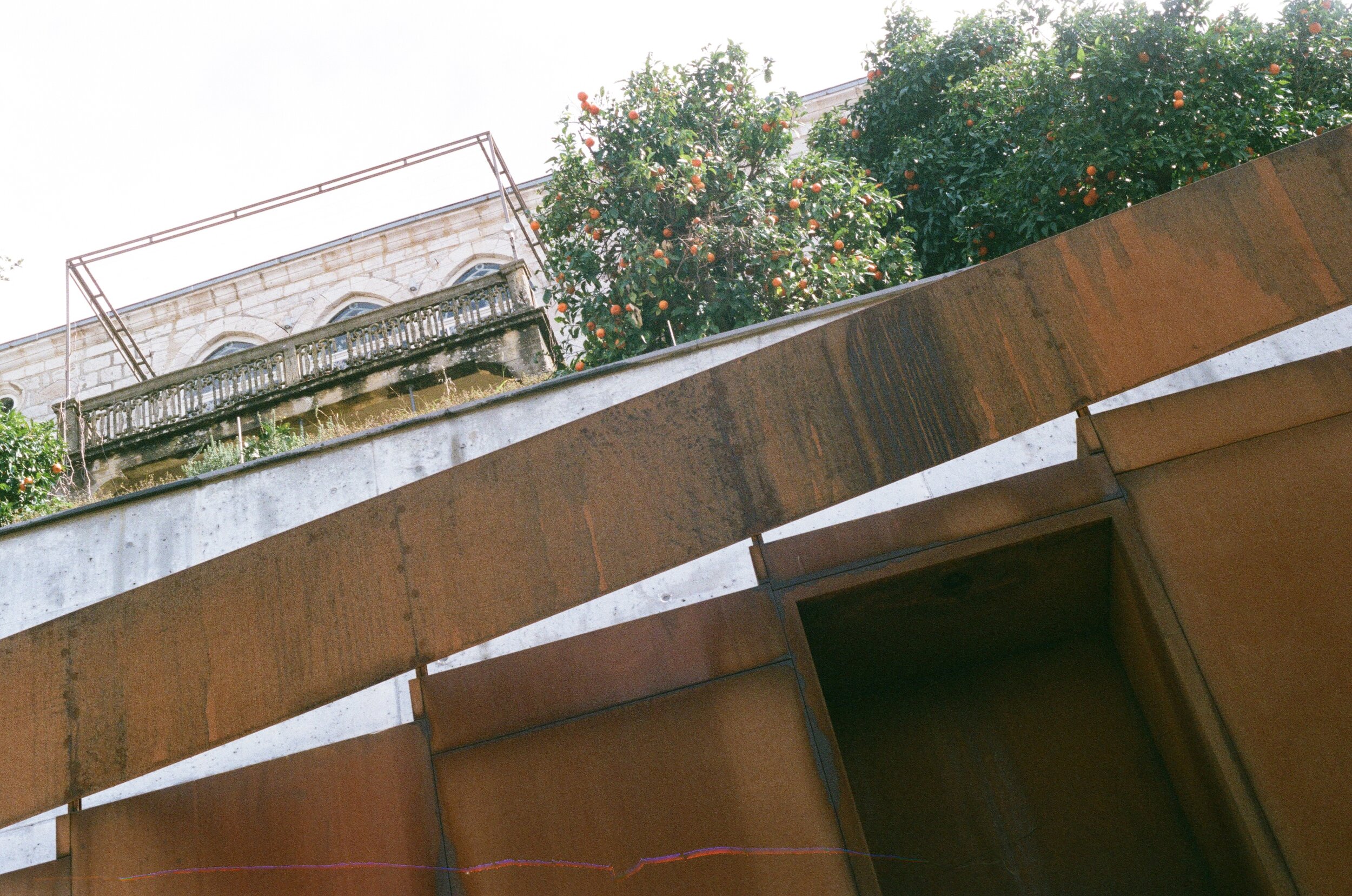
Kneeling, standing or sitting in the presence of God
In most Byzantine and Orthodox churches, one might be surprised to find there are no pews. The reason behind this dates to the Protestant Reformation in Europe.
During worship services, Protestant churches did not put emphasis on the liturgical movements, but on the sermon given by the preacher. The interpretation of the Bible by Pastors took center-stage and soon the act of standing, or kneeling gave place to sitting.
When wooden pews appeared in Protestant Temples, the Roman Catholic Church decided to follow the trend. Catholics first bought their own pews, but soon Churchwarden’s started renting them out to Catholics. Prices would vary depending on location and pews soon became an evident marker of social divide. Rich families sat close to the altar whereas poor families would be found at the back.
To this day, most Eastern churches do not have pews and vigorously defend this choice.
Believed to be a passive act, one that creates distance and imbalance between priests and their congregation, sitting is rarely practiced. In the Orthodox Church, a good standing posture is considered essential when receiving liturgy, not as an individual but as a connected group standing close together in the face of God.
sunbathing on Beirut's seafront
Our prelude CITRUS, CEDRUS and MOON curation is now online. Summer will be on the moon, on Beirut’s lunar seafront which still awaits construction…
The waterfront provides a unique meeting area for Beirutis in search of a wide open public space and marks the starting point of the road leading to Damascus.
Imagined during our long walks on this unusual wasteland, we are currently crafting our Damascus ROWSE curation which will available for Fall/Winter 2020.
Our prelude CITRUS, CEDRUS and MOON curation is now online. Summer will be on the moon on Beirut’s lunar seafront which still awaits construction…
The waterfront provides a unique meeting area for Beirutis in search of a wide open public space and marks the starting point of the road leading to Damascus.
Imagined during our long walks on this unusual wasteland, we are currently crafting our Damask ROWSE curation which will be available for Fall/Winter 2020.
This unique space with its huge cement blocks randomly scattered on the sand draws families and children zooming past joggers on their yellow rented bicycles and lovers looking out onto the Mediterranean Sea as the sun sets…
Damask ROWSE will launch in September 2020.
Have a look at our current curation
With “a little life” Sara Boy opens a new chapter being now based in Paris
After her first EP urotour Sara Boy comes back with a little life first single of her next chapter.
a little life comes after having recently collaborated with Stockholm-based producer Neeco Delaf on spring never comes out recalling her time in Dubai. It combines Sara Boy’s emotional ambient sounds and singular voice layerings with powerful lyrics about culture, ancestry, the value of success and the infinite number of lives and perspectives that surround her
The release of the song will be followed by a video on the 23rd of July on middle eastern media Balkoon of a live performance in Pavilion MMXX in Beirut an exhibition curated by André Damas
Sara Boy grew up in South-East Asia but is of French origin. During her high school years she joined a local choir and discovered the Allegri’s Miserere and the power of Gregorian chants, while constantly listening to soul, folk and RnB singersongwriters. She still draws on this classical repertoire in her songwriting, as her melodies involve multiple vocal layerings and harmonies, giving them an ethereal almost spiritual feel.
Sara Boy released her first EP urotour in 2018 where she poetically speaks about belonging or the lack of it in a globalised world. Showcased on Beehype’s Best tracks of 2018 from the Middle East compilation, Sara Boy finds inspiration in her past and current peregrinations between the East and West.
After her time spent in the Middle East, Sara Boy is now based in Paris and is currently working on her new EP.
follow Sara Boy
a little life
More blog postes about Sara Boy
Sara Boy collaborates with stockholm-based producer Neeco Delaf on "spring never comes out"
spring never comes out
Neeco Delaf and Sara Boy
« spring never comes out » in 2020. We’re slowly coming out of the great lockdown and heading into summer with Neeco Delaf and Sara Boy wondering where spring went.
Both French but having lived abroad, they discovered each other online during the quarantine. Their track « spring never comes out » addresses the need for physicality in the digital age. When half of mankind went under lockdown whilst nature followed its course, if we didn’t experience the coming of spring, where did we go?
Neeco Delaf produces intricate and melancholic music. The kicks hit you and the ethereal synths move you. He uses complex sonorities where verses and choruses alternate smoothy in a falsely deconstructed manner.
Echoing her song 26 released in 2018 Sara Boy’s mellow voice questions the reality of our existence when social distancing becomes the norm and the only reality is virtual.
Sara Boy is a singer-songwriter of French origin who grew up in South-East Asia.
Based in Paris since 2020 Sara Boy is currently preparing her next EP. A first extract, a little life will be released in July alongside a Cube Sessions, an intimate live video performance captured by Beirut based digital media Balkoon.
Penone at the Palais d’Iéna
In 2013, Giuseppe Penone’s powerful tree sculptures placed on the Royal Way’s immaculate cut grass had created a sensation in Versailles by contrasting with André le Nôtre’s controlled landscaped gardens designed more than 400 years ago.
Penone’s collaboration with Versailles commenced in 1999 when he was able to buy two dead cedar tree trunks from the remains of a thunderstorm. Cedro di Versailles and Tea scorza e scorza (Between Bark and Bark) were made from those tree trunks and highlight the artist’s intention not to shape nature and alienate it from man but rather to show how man and nature bear resemblance to one another.
In 2019 Penone later occupied the hypostyle hall of the Palais Iena which houses the French Economic Environmental Council with his monumental installation Matrice di linfa, a large scale tree sculpture cut open like sacrificial altar.
MORE ENTITRE
A hidden gem in the Royal Stables of Versailles
Away from the public eye, only a few feet away from the Château of Versailles securely stored inside the Royal Stables, lies an unsuspected treasure: the Louvre Museum’s unbelievable gallery of plaster casts of the Department of Greek, Etruscan and Roman Antiquites.
The mouldings of the Winged Victory of Samothrace with and without her wings, the nymphs of Girardon, the metopes of the Parthenon and even the colonnades of the Temple of Castor and Pollux can quietly be observed inside the stone vaulted high-ceilinged wings of the Small Stable built between 1679 and 1682 by Jules Hardouin-Mansart.
Formerly stored in the Louvre Museum, the casts landed in Versailles in 1970 after the events of May 1968 when protesters managed to destroy half the plaster collection considering it a symbol of academicism and artistic rigour. Between 1970 and 1978 more than a hundred casts were reassembled but then left untouched until 1999, when the Louvre’s Department of Greek, Etuscan and Roman Antiquities launched the initiative to restore the entire collection. The gypsothèque in Versailles finally opened in 2014 after multiple restorations and a minute research work regarding the mouldings origin.
MORE ENTITRE
is life without Christo still bearable?
sketches of Christo’s L’Arc de Triomphe,Wrapped on sale at the 2020 BRAFA
He was meant to wrap the Arc de Triomphe in September MMXX and add his touch to the grandparis but on May 31st Christo, the poetic landscape artist, sadly passed away.
We found Christo’s 2016 floating Piers installation on Lake Iseo in Italy particularly moving as it was executed a few years after his wife’s death and was a project they both had at heart to execute. After multiple failed attempts in Rio de Plata in Argentina and Tokya Bay in Japan, Christo got the permission to extend his orange fabric on the surface of the lake Iseo in 2016 to everyone’s delight, a surreal experience that attracted crowds of visitors.
Born in Bulgaria in 1935, Christo Vladimiroff Javacheff attended the Fine Arts Academy in Sofia and first started his artistic career as a portrait painter in Paris after fleeing Prague when the Hungarian Revolution of 1956 broke out.
In Paris, he met his future wife and artistic soulmate Jeanne-Claude Denat de Guillebon - with whom he later formed the inseparable artistic duo “Christo”- upon the delivery of a portrait he had made of her mother.
With Jeanne-Claude, his work took another dimension and he quickly dismissed painting to focus solely on stacking, wrapping and obscuring surfaces and objects. The couple soon began collaborating together on monumental scale environmental wrappings; Christo would sketch and conceptualise and Jeanne-Claude would enable their conception in the physical world.
By wrapping objects, and later altering entire landscapes, Christo and Jeanne-Claude’s work questions their very nature our relationship to them. Christo’s approach to art was unique in multiple ways, he was never signed to a gallery and was the sole commissioner of all his works which he funded by selling the sketches of his future installations.
L’Arc de Triomphe,Wrapped sketches on sale at the 2020 BRAFA
Christo’s L’Arc de Triomphe,Wrapped installation is now rescheduled to September MMXXI as a posthume tribute to the late artists’ body of work.
justwaitingforradiantday.
check the CITRUS prelude
The Pont Alexandre III
World Exhibitions effectively contribute to the construction of cities and to their international aura. What do the Eiffel Tower, the Grand Palais and the Pont Alexandre iii have in common? They were all inaugurated in the context of a World Exhibition and still greatly contribute to Paris’ prestige by continuously attracting millions of local and foreign visitors everyday.
The pont Alexandre iii, situated between the Invalides and the GrandParis and named after the Russian Tsar Alexandre iii was completed in 1900 and was to represent the Franco-Russian alliance in a complicated diplomatic context with the German Empire.
Enjoy a casual day on the Pont Alexandre iii:
The arched bridge is not only one of the most beautiful in Paris to this day, it also represents one that required great innovative technical abilities to build at the time. The architects and engineers comissioned at the time had been instructed to find a way to design a continous river-crossing that was to follow the Champs Elysées’ axis right up to the Invalides Esplanade without obstructing its view.
Seventeen artists collaborated on the decorative programme of this splendid bridge. In the center of the arch, the nymph of Seine and Neva river continues to symbolise the friendship between the two countries, which maintained their alliance 14 years after the first World War.
Due to covid-19, the next World Exhibition: the Dubai Expo 2020 has been postponed to 2021 and will be held from October 1st 2021 - March 31st 2022.
the Angle(L) And(W) the Curve(J) in the grandparis by André Chami
Built and inaugurated in Paris for the MCMXXXVIII Universal Exhibition, the Palais de Tokyo’s function as a museum has evolved over the years to become not only an avant-guard space for contemporary art but also a social hub for creatives.
Currently, after seventy seven years of existence in the public space, Alfred Janniot’s two-sided bas relief framework ‘Legend of the Sea’ and ‘Legend of the Earth’ is being restored.
Since the 1990’s the Palais de Tokyo’s forecourt and Janniot’s large sandy-coloured carved frescos have hosted generations of skateboarders who come to enjoy the space’s aesthetic vastness and tranquility at the heart of the city.
For the 2015 Wool Week, curator André Chami and LWJ designed a performative art piece on the Palais de Tokyo’s forecourt to capture skateboarders’ repetitive pattern thanks to a giant printing machine archiving their movements onto ink on square pieces of wool.
The concave trajectories of the skateboarders activity on delimited squares of wool perfectly embodies the essence of LWJ - the angle(L) and(W) the curve(J).
The overall performance was accompanied by a live synesthetic acoustic piece by artists Luca Ventimiglia and Victor Nebbiolo Di Castri. Enjoy watching the piece here:
As a tribute to matter in the digital age, we chose Alfred Janniot’s timeless sculptural fresco as the backdrop for our CITRUS prelude curation photo shoot. This unlocked LWJ’s printed 3x3m blue-ink on wool artworks created in MMXV.
Continue your exploration with:
one of the eighth printed wool sheet
have a look at our CITRUS prelude curation
Sara Boy thinks too much
Singer-songwriter based in dubaiii deals with representation and questions the reality of her existence in the world.
Sara grew up in South-East Asia and is now part of lviii dubaiii.
She spends her time between her room and the swimming pool, living like a Capuchin monk around repetitive routines.
Watch her training video:
The soundtrack is Sara Boy's piece you think too much extracted from her mixtape Dubaiii released in oct. mmxvii.
Stream you think too much on SoundCloud:


















































































































